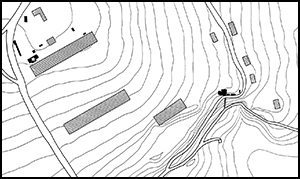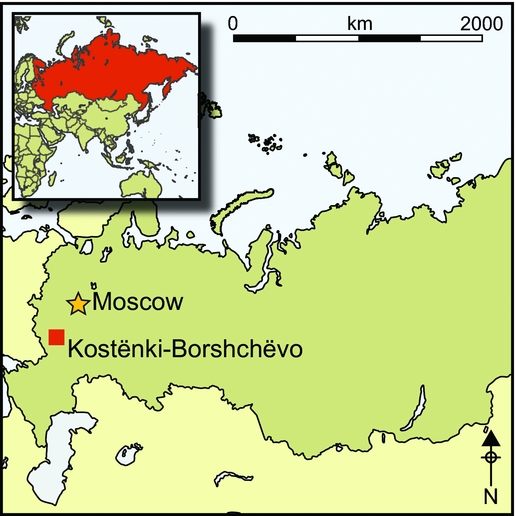
Introduction
The Upper Palaeolithic record of European Russia is dominated by the Kostënki-Borshchëvo complex of sites, approximately 40km south of Voronezh (Figure 1). A total of 26 open-air Upper Palaeolithic sites have been found there, in and around the villages of Kostënki and Borshchëvo on the west side of the River Don. As well as being individually named, each of these sites is referred to by a number: Kostënki 1–21 and Borshchëvo 1–5 (Figure 2). More than half of the sites have yielded archaeological material from at least one period of the Mid Upper Palaeolithic (MUP; c. 30–22 14C kya BP) (Praslov & Rogachëv Reference Rogachëv, Beliaeva, Praslov and Rogachëv1982; Sinitsyn Reference Sinitsyn2007, Reference Sinitsyn and Sanz2015).
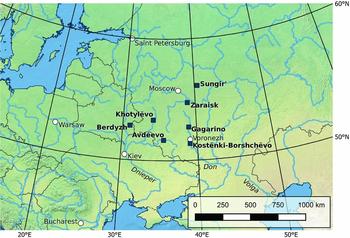
Figure 1. Map showing the locations of Russian and Belarusian sites mentioned in the text.
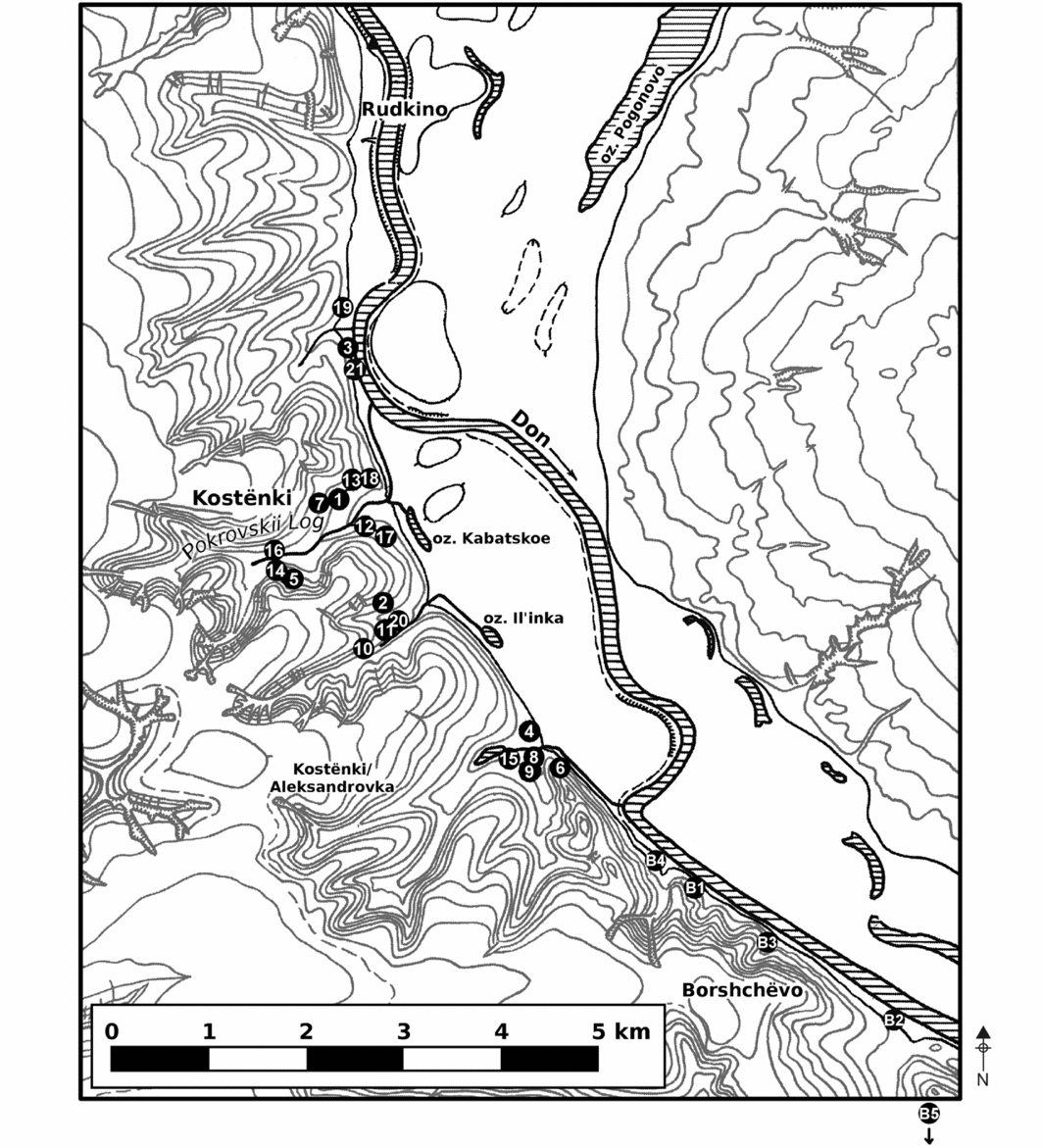
Figure 2. Map showing the locations of the Kostënki-Borshchëvo Upper Palaeolithic sites (sites 1–21 refer to the Kostënki sites, while sites B1–B5 refer to the Borshchëvo sites). Contour interval: 10m. (Modified (with permission) after map by I.I. Krasnov, in Praslov & Rogachëv Reference Rogachëv, Praslov, Anikovich, Beliaeva, Dmitrieva, Praslov and Rogachëv1982.)
In European Russia, as across Europe, most MUP archaeological assemblages are described as Gravettian. The definition and usage of the term Gravettian has a complex history, and today is used inconsistently (Peña Alonso Reference Peña Alonso2012; Noiret Reference Noiret and Otte2013; Pesesse Reference Pesesse and Otte2013). For some it is a chronological designation used synonymously or near synonymously with MUP; for others it helps to describe an assemblage's contents. We incline towards the latter viewpoint, and suggest that the term Gravettian be reserved for MUP assemblages that include the systematic production of backed lithic artefacts, including Gravette points, microgravettes and shouldered points. A significant proportion of Russian MUP assemblages do not meet this definition of Gravettian (Djindjian et al. Reference Djindjian, Kozłowski and Otte1999; Noiret Reference Noiret and Otte2013; Sinitsyn Reference Sinitsyn and Sanz2015).
A notable feature of the European MUP is the relative abundance of human burials, especially in comparison with the preceding Early Upper Palaeolithic (EUP), and connections between Gravettian assemblages and human burials have been repeatedly emphasised (e.g. Formicola Reference Formicola2007; Henry-Gambier Reference Henry-Gambier2008; Pettitt Reference Pettitt2011; Riel-Salvatore & Gravel-Miguel Reference Riel-Salvatore, Gravel-Miguel, Nilsson Stutz and Tarlow2013). Numerous MUP single and multiple burials have been found, many of which contained large amounts of ochre, items of personal ornamentation and grave goods. Well-known examples include those from Dolní Věstonice (Czech Republic), the Balzi Rossi (Grimaldi) Caves (Italy) and Krems-Wachtberg (Austria) (Klima Reference Klima1988; Mussi Reference Mussi and Otte1995; Einwögerer et al. Reference Einwögerer, Händel, Neugebauer-Maresch, Simon, Teschler-Nicola and Bacvarov2008).
The best-known Russian Palaeolithic burials—and some of the most extraordinary discoveries of the entire Upper Palaeolithic—were found at Sungir’, almost 200km east of Moscow (Figure 1) (Bader Reference Bader1967, Reference Bader and Rybakov1970; Bader & Lavrushin Reference Bader and Lavrushin1998; Trinkaus et al. Reference Trinkaus, Buzhilova, Mednikova and Dobrovolskaya2014). The record of EUP/MUP funerary activity elsewhere in European Russia is confined to the Kostënki-Borshchëvo sites, and is less well known internationally. Burials have been found at Kostënki 2, 12, 14 and 15, while fragmentary human remains have been found at several other sites (Gerasimova Reference Gerasimova, Praslov and Rogachëv1982; Sinitsyn Reference Sinitsyn and Otte2004; Gerasimova et al. Reference Gerasimova, Astakhov and Velichko2007). As outlined below, some of these burials apparently date to the MUP, while others date to the EUP. None, however, are associated with a Gravettian lithic assemblage.
Finally, there is also the burial of a child found at Kostënki 18. The main archaeological layer at Kostënki 18 is attributed to the late Gravettian ‘Kostënki-Avdeevo Culture’ due to its lithic assemblage (Rogachëv & Beliaeva Reference Rogachëv, Beliaeva, Praslov and Rogachëv1982), and a connection between the burial and this archaeological layer has been assumed but not firmly demonstrated. Here, we reassess Kostënki 18 in the light of a new radiocarbon date for the burial, and consider its status as the only plausibly Gravettian burial in Russia.
Kostënki 18
Kostënki 18 (also known as Khvoikovskaia) is located close to the mouth of Pokrovskii Log ravine, around 200m from Kostënki 13 and 400m from Kostënki 1 (Figure 2). The site was discovered by A.N. Rogachëv in 1953 during investigation into construction work. At this time, the child burial was identified and excavated along with several other archaeological features, including Palaeolithic pits. A total of approximately 115m2 was dug that year across several locations up to around 200m apart (Figure 3). Later, in 1959, four small test-pits were dug, one of which was subsequently enlarged in the same season to a 7 × 6m excavation area. The 1959 fieldwork established the presence of a sizeable layer of Palaeolithic material (covering almost the entire area of the 7 × 6m excavation) (Rogachëv & Beliaeva Reference Rogachëv, Beliaeva, Praslov and Rogachëv1982).
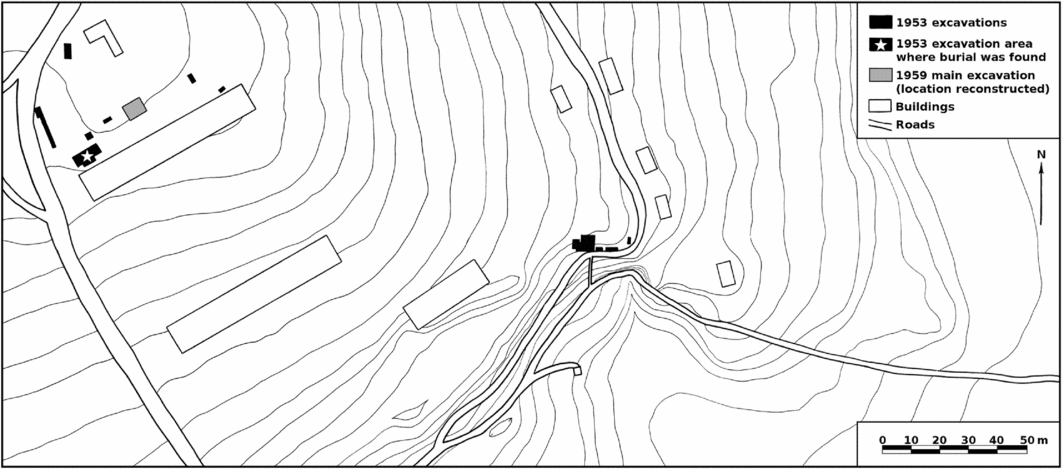
Figure 3. Map showing the locations of the Kostënki 18 excavations. The location of the 1953 excavations and buildings are based on the original plans from the excavation report (Rogachëv Reference Rogachëv1959). The location of the principal 1959 excavations has been reconstructed based on excavation square numbers and cannot be regarded as definitive. Contour interval: 1m. (Modified after a figure by A.N. Rogachëv, IIMK RAN Archives, 1953, photograph number: O.2068-13, published with permission of IIMK RAN.)
The Kostënki 18 grave and its contents were badly affected by earthworks made during the mid twentieth century and earlier. By the time the burial was identified and excavated by archaeologists, a significant part of the grave and the surrounding area had been destroyed on both sides (Figures 4–6), and only the north-eastern edge of the original grave pit was found to be intact. The undisturbed portion of the grave was sub-triangular in form and measured around 1.2 × 0.52m, although the original size and shape of the grave cut are unknown. The base of the grave could only be delineated by the location of the skeletal remains: Rogachëv was unable to define a cut or any other sediment change (Rogachëv Reference Rogachëv1955; Rogachëv & Beliaeva Reference Rogachëv, Beliaeva, Praslov and Rogachëv1982).
Within the burial pit were the remains of a child, originally assessed as being around 6–7 years of age (Rogachëv Reference Rogachëv1955), and later as around 9–10 years old (Gerasimova Reference Gerasimova, Praslov and Rogachëv1982). The individual had apparently been laid in a partially flexed position on their left side with the head oriented towards the south-west, facing north-west (Figures 4–7). The skeleton was incomplete—in particular, the limb bones had been destroyed distally from the mid humeri and mid femora (Rogachëv Reference Rogachëv1955; Rogachëv & Beliaeva Reference Rogachëv, Beliaeva, Praslov and Rogachëv1982).
Above the human remains were three layers, 0.35m thick in total, of badly decayed mammoth bones and tusks in various artificial arrangements. These had been partially destroyed prior to Rogachëv's investigation (Figure 4) but were interpreted as having formed part of the grave deposit (Figure 7). The uppermost layer was made up of a dense arrangement of bones and tusk fragments, lying perpendicular to the child's torso. Below this was a similar series of bones lying in approximately the same orientation as the torso. In the lowermost layer were two fragments of scapula, positioned above the child's head and chest, and two long bones found at an angle to those in the overlying layer (Rogachëv Reference Rogachëv1955; Rogachëv & Beliaeva Reference Rogachëv, Beliaeva, Praslov and Rogachëv1982).
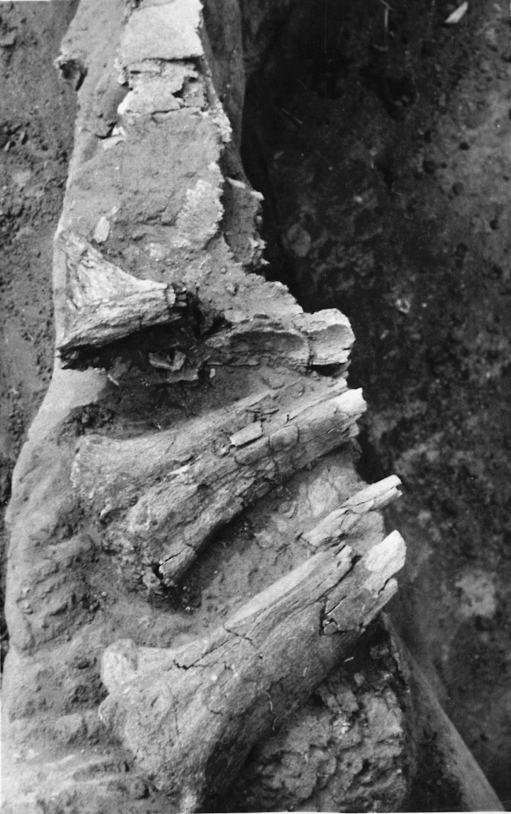
Figure 4. Photograph showing mammoth bones constituting part of the grave fill at Kostënki 18 (photograph: Rogachëv Reference Rogachëv1953, IA RAN Archives F.1 R.1 number 850, fig. 17, published with permission of IA RAN).
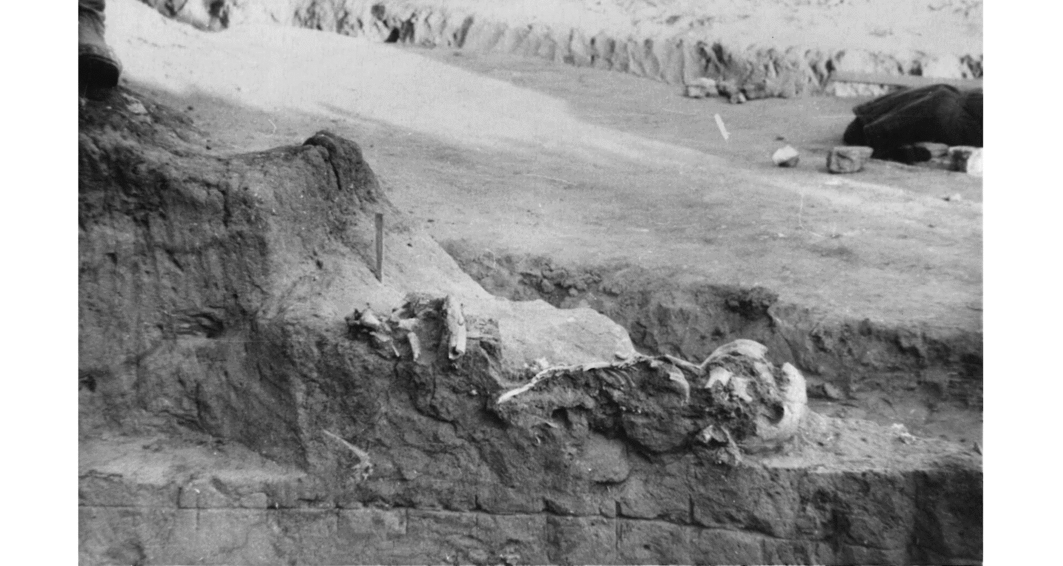
Figure 5. Photograph showing the Kostënki 18 human remains (view from the north-west) (photograph: Rogachëv Reference Rogachëv1953, IA RAN Archives F.1 R.1 number 850, fig. 18, published with permission of IA RAN).
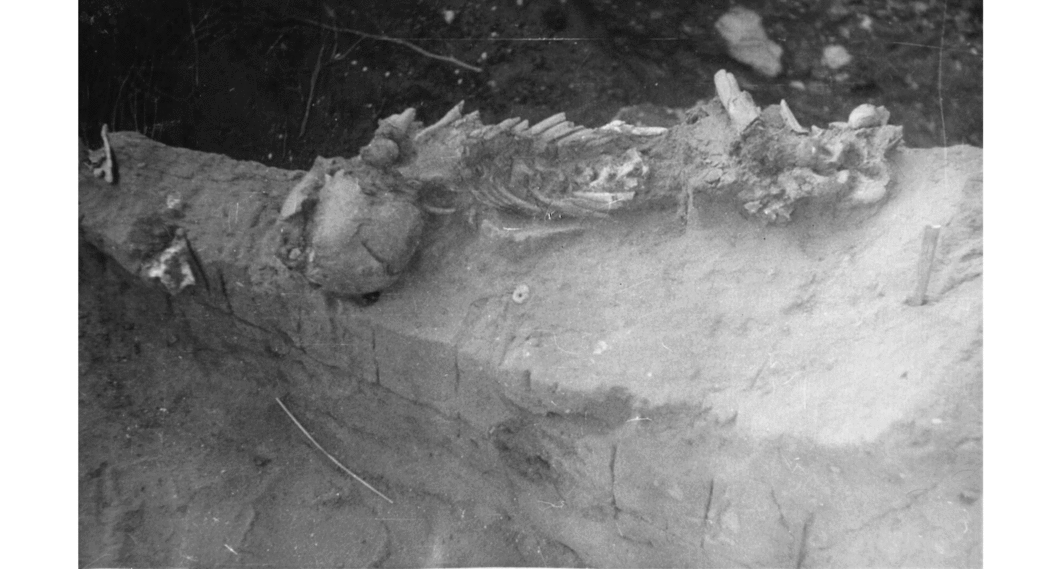
Figure 6. Photograph showing the Kostënki 18 human remains (view from the south-east) (photograph: Rogachëv Reference Rogachëv1953, IA RAN Archives F.1 R.1 number 850, fig. 19, published with permission of IA RAN).
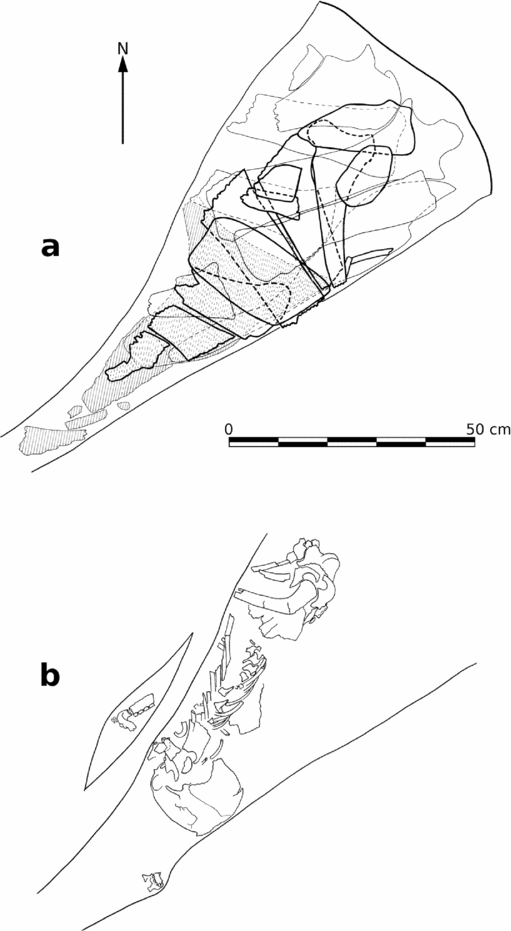
Figure 7. Plan of: a) the bones found above the skeleton, and b) the recovered skeleton itself. (Modified after a figure by A.N. Rogachëv, IIMK RAN Archives, 1953, photograph number: O.2068-15, published with permission of IIMK RAN.)
With the exception of the mammoth bones, no grave goods were found, and no ochre or charcoal was identified in association with the human remains. No in situ Palaeolithic cultural layer was found in the grave's immediate vicinity and, although Rogachëv estimated the original grave pit to be at least 0.4m deep, he was not able to determine the original level from which the pit had been dug (Rogachëv & Beliaeva Reference Rogachëv, Beliaeva, Praslov and Rogachëv1982). The precise stratigraphic relationship between the burial and the other archaeological remains at Kostënki 18 is therefore impossible to establish.
The radiocarbon age of the Kostënki 18 burial
Despite intensive efforts, the direct dating of Upper Palaeolithic human bone has proved challenging, especially when glues and other preservatives have been applied. These can be very difficult to remove from samples prior to radiocarbon dating, and, if incompletely removed, can lead to results that are offset by thousands of years from the sample's trueradiocarbon age (see Jacobi & Higham Reference Jacobi and Higham2008; Marom et al. Reference Marom, McCullagh, Higham, Sinitsyn and Hedges2012, Reference Bessudnov and Sinitsyna2013).
In an attempt to address this problem, single amino acid radiocarbon dating has been developed and applied to Palaeolithic human material, with mostly encouraging results (Marom et al. Reference Marom, McCullagh, Higham, Sinitsyn and Hedges2012, Reference Bessudnov and Sinitsyna2013; Nalawade-Chavan et al. Reference Nalawade-Chavan, McCullagh and Hedges2014). The method involves the separation of the amino acids from a bone collagen sample using preparative high-performance liquid chromatography (HPLC) and isolation of the amino acid hydroxyproline (Hyp), which is almost only ever naturally found in mammalian collagen. By isolating this amino acid, all potential contaminants (except collagen-based glues or preservatives) can be excluded. Due to the often small size of the extracted hydroxyproline fraction, the samples must be dated using AMS methods (McCullagh et al. Reference McCullagh, Marom and Hedges2010). Finally, the radiocarbon dates obtained are corrected to compensate for the additional ‘background’ input of carbon related to the use of HPLC (Nalawade-Chavan et al. Reference Nalawade-Chavan, McCullagh and Hedges2014).
Many of the human remains excavated from Kostënki-Borshchëvo during the mid twentieth century were conserved with glues and preservatives. This is certainly the case for the Kostënki 18 skeleton, which was visibly heavily treated with glue. The previous dates from the skeleton are not in statistical agreement: 21020±180 14C BP (OxA-7128) and 19830±120 14C BP (GrA-9304) (Table 1). To produce a more reliable age estimate, we conducted single amino acid radiocarbon dating on a sample of rib bone fragments from the collections held at the Institute for the History of Material Culture (IIMK) in Saint Petersburg. The approach was based on that previously outlined by Nalawade-Chavan et al. (Reference Nalawade-Chavan, McCullagh and Hedges2014), including their date correction algorithm. The final corrected result of 23440±150 14C BP (OxA-X-2666-53 (Hyp)) is more than 2000 radiocarbon years older than the older of the two previous dates (Table 2). Using the IntCal13 curve and OxCal v4.2, a calibrated age of 27840–27390 cal BP (95.4% probability) or 27740–27510 cal BP (68.2% probability) was produced (Figure 8; Bronk Ramsey Reference Bronk Ramsey2009; Reimer et al. Reference Reimer, Bard, Bayliss, Beck, Blackwell, Bronk Ramsey, Buck, Cheng, Edwards, Friedrich, Grootes, Guilderson, Haflidason, Hajdas, Hatté, Heaton, Hoffmann, Hogg, Hughen, Kaiser, Kromer, Manning, Niu, Reimer, Richards, Scott, Southon, Staff, Turney and van der Plicht2013).
Table 1. Previously published radiocarbon dates for Kostënki 18 ranked by age BP.

Table 2. The new radiocarbon date for Kostënki 18: results and calibrated age ranges. The corrected 14C age has been adjusted to allow for the carbon contribution derived from the HPLC process (Nalawade-Chavan et al. Reference Nalawade-Chavan, McCullagh and Hedges2014) and should be treated as the definitive result; calibrated against the IntCal13 curve using OxCal v4.2 (Bronk Ramsey Reference Bronk Ramsey2009; Reimer et al. Reference Reimer, Bard, Bayliss, Beck, Blackwell, Bronk Ramsey, Buck, Cheng, Edwards, Friedrich, Grootes, Guilderson, Haflidason, Hajdas, Hatté, Heaton, Hoffmann, Hogg, Hughen, Kaiser, Kromer, Manning, Niu, Reimer, Richards, Scott, Southon, Staff, Turney and van der Plicht2013).


Figure 8. The new date for the Kostënki 18 human remains (rib sample) calibrated against IntCal13; plot generated using OxCal v4.2. Brackets below plot indicate 95.4% and 68.2% probability ranges (Bronk Ramsey Reference Bronk Ramsey2009; Reimer et al. Reference Reimer, Bard, Bayliss, Beck, Blackwell, Bronk Ramsey, Buck, Cheng, Edwards, Friedrich, Grootes, Guilderson, Haflidason, Hajdas, Hatté, Heaton, Hoffmann, Hogg, Hughen, Kaiser, Kromer, Manning, Niu, Reimer, Richards, Scott, Southon, Staff, Turney and van der Plicht2013).
Discussion: Kostënki 18, the Kostënki-Avdeevo Culture and Early and Mid Upper Palaeolithic burials in European Russia
The archaeological record for earlier Gravettian sites in Russia is sparse, with only three Gravettian sites radiocarbon-dated to the period between 28000 and 24000 14C BP (Kostënki 8 Layer II, Kostënki 4 and Borshchëvo 5 Layer I: Reynolds et al. Reference Reynolds, Lisitsyn, Sablin, Barton and Higham2015). A greater number of sites are attributed to the later Gravettian Kostënki-Avdeevo Culture. This grouping is characterised by the presence of backed shouldered points, Kostënki knives and, frequently, female ‘Venus figurine’ sculptures. Decorated bone artefacts and particular features relating to the spatial organisation of sites have also been seen as important for the definition of the grouping. The large sites of Kostënki 1 Layer I, Avdeevo and Zaraisk are ordinarily attributed to the Kostënki-Avdeevo Culture, as are smaller sites including Kostënki 13 and Kostënki 14 Layer I, as well as Kostënki 18. The question of whether the sites of Khotylëvo-2 and Gagarino should be included is not fully resolved, while the site of Berdyzh in Belarus is often included on the basis of a relatively limited lithic assemblage (Gvozdover Reference Gvozdover1995; Gavrilov Reference Gavrilov and Amirkhanov2004; Sinitsyn Reference Sinitsyn2007, Reference Sinitsyn and Sinitsyna2013, Reference Sinitsyn and Sanz2015; see Klaric et al. Reference Klaric, Lev, Giria and Polanská2015 for a detailed discussion of Kostënki knives).
Beyond Russia, the Kostënki-Avdeevo Culture is often connected with the ‘shouldered-point horizon’ sites of Central Europe, and sometimes these Central and Eastern European sites with shouldered points are combined under the umbrella term ‘Kostënki-Willendorfian’, or a similar designation (e.g. Grigor'ev Reference Grigor'ev, Soffer and Praslov1993; Gvozdover Reference Gvozdover1995; Svoboda Reference Svoboda2007; Noiret Reference Noiret and Otte2013; see also Kozłowski Reference Kozłowski1986). The period post-dating the Kostënki-Avdeevo Culture in Russia is not well understood, although some Kostënki sites that apparently date to the very end of the MUP or the beginning of the Late Upper Palaeolithic appear to be distinct from Gravettian sites and are attributed to the Zamiatnin Culture (Anikovich et al. Reference Anikovich, Popov, Platonova, Anikovich, Popov and Platonova2008; Bessudnov Reference Bessudnov and Sinitsyna2013; Sinitsyn Reference Sinitsyn and Sanz2015).
The Upper Palaeolithic lithic assemblage of Kostënki 18, found mostly during the 1959 excavations (i.e. in a separate year and area to the burial), totals more than 1000 pieces, of which over 100 are retouched. The retouched assemblage includes backed bladelets, burins and nine complete and 42 possible fragmentary shouldered points (Rogachëv Reference Rogachëv1959). Although they vary somewhat in form and size, similarities have been seen between these shouldered points and those from Layer I at neighbouring Kostënki 1 (Rogachëv & Beliaeva Reference Rogachëv, Beliaeva, Praslov and Rogachëv1982; Bessudnov Reference Bessudnov and Kileinikov2009). The presence of 28 complete and fragmentary Kostënki knives from Kostënki 18 has also been noted (Rogachëv Reference Rogachëv1959; Rogachëv & Beliaeva Reference Rogachëv, Beliaeva, Praslov and Rogachëv1982).
As outlined above, it is difficult to establish an association between the Kostënki 18 burial and the Kostënki 18 cultural layer, and hence with the Kostënki-Avdeevo Culture. There are no grave goods that can be used to link the burial with the cultural layer, and beyond their presence in the same broad geological unit, there is no stratigraphic information demonstrating an association. Any argument for contemporaneity of the burial and the other archaeological material at Kostënki 18 must therefore rely on dating evidence.
No radiocarbon dates are available for the Kostënki 18 cultural layer: only material from the burial has produced published dates (Table 1). The principal sites of the Kostënki-Avdeevo Culture—Kostënki 1 Layer I, Avdeevo and Zaraisk—have each provided more than 25 dates (Damblon et al. Reference Damblon, Haesaerts and van der Plicht1996; Sinitsyn et al. Reference Sinitsyn, Praslov, Svezhentsev, Sulerzhitskii, Sinitsyn and Praslov1997; Amirkhanov Reference Amirkhanov2000; Abramova et al. Reference Abramova, Grigorieva and Zaitseva2001; Vermeersch Reference Vermeersch2017). At each site, the dates span a rather wide chronological range, which is probably due to the difficulty in producing accurate radiocarbon dates for this period (Damblon et al. Reference Damblon, Haesaerts and van der Plicht1996; Higham Reference Higham2011). In our experience, and as borne out by redating work (e.g. Douka et al. Reference Douka, Higham and Sinitsyn2010; Reynolds et al. Reference Reynolds, Lisitsyn, Sablin, Barton and Higham2015), the most ancient dates for each of the Kostënki sites or layers can generally be treated as more accurate than younger dates. This is because erroneous dates for this period tend to appear younger, rather than older, than the true ages of the samples (Higham Reference Higham2011), and hence, for any given layer, more recent dates need to be treated with greater caution than more ancient dates.
The most ancient published dates for Kostënki 1 Layer I are around 24000–23500 14C BP, as compared with around 23500–22000 14C BP for Avdeevo and around 23000–22000 14C BP for Zaraisk (Damblon et al. Reference Damblon, Haesaerts and van der Plicht1996; Sinitsyn et al. Reference Sinitsyn, Praslov, Svezhentsev, Sulerzhitskii, Sinitsyn and Praslov1997; Amirkhanov Reference Amirkhanov2000; Abramova et al. Reference Abramova, Grigorieva and Zaitseva2001; Vermeersch Reference Vermeersch2017). Taken together these suggest an age range of c. 24000–22000 14C BP for the Kostënki-Avdeevo Culture (c. 28500–26000 cal BP when calibrated against the IntCal13 curve using OxCal v4.2; Bronk Ramsey Reference Bronk Ramsey2009; Reimer et al. Reference Reimer, Bard, Bayliss, Beck, Blackwell, Bronk Ramsey, Buck, Cheng, Edwards, Friedrich, Grootes, Guilderson, Haflidason, Hajdas, Hatté, Heaton, Hoffmann, Hogg, Hughen, Kaiser, Kromer, Manning, Niu, Reimer, Richards, Scott, Southon, Staff, Turney and van der Plicht2013). The new date for the Kostënki 18 burial (23440±150 14C BP; OxA-X-2666-53 (Hyp); Table 2) indicates contemporaneity with the Kostënki-Avdeevo Culture and, by extension, broad contemporaneity with the Kostënki 18 cultural layer.
It is striking that all four of Kostënki's Kostënki-Avdeevo Culture sites—Kostënki 18, Kostënki 1 Layer I, Kostënki 13 and Kostënki 14 Layer I—are found within Pokrovskii Log, with the first three found within only a few hundred metres of each other (Figure 2). Of these sites, Kostënki 1 Layer I shows evidence for the most intensive occupation. Here, two complexes of features were found: parallel lines of hearths surrounded by pits and concentrations of archaeological material (Klein Reference Klein1969; Rogachëv et al. Reference Rogachëv, Praslov, Anikovich, Beliaeva, Dmitrieva, Praslov and Rogachëv1982). The eastern complex alone covered more than 600m2 and represents a significant area of human activity, with a large lithic assemblage of over 40000 pieces, as well as osseous material and faunal remains (Rogachëv et al. Reference Rogachëv, Praslov, Anikovich, Beliaeva, Dmitrieva, Praslov and Rogachëv1982; Anikovich et al. Reference Anikovich, Popov, Platonova, Anikovich, Popov and Platonova2008). Activity at the other three Kostënki-Avdeevo Culture sites in Pokrovskii Log appears to have been much more limited. As a result, it has been proposed that Kostënki 18, Kostënki 1 Layer I and Kostënki 13 represent parts of a single settlement complex centred on Kostënki 1 (Sinitsyn Reference Sinitsyn2007, Reference Sinitsyn and Sinitsyna2013; Anikovich et al. Reference Anikovich, Popov, Platonova, Anikovich, Popov and Platonova2008; Bessudnov Reference Bessudnov and Kileinikov2009; but see Amirkhanov et al. Reference Amirkhanov, Lev and Seleznëv2001). The new date does not contradict these interpretations.
As stated above, we reserve the term ‘Gravettian’ for MUP assemblages showing evidence of the systematic production of backed lithics. If we use this definition, and accept a link between the Kostënki 18 human remains and the lithic assemblage found at the site, the Kostënki 18 burial stands alone among the corpus of EUP/MUP burials in European Russia in being associated with a Gravettian archaeological assemblage. The ochre-stained burial from Kostënki 14, which has previously been described as MUP (e.g. Pettitt Reference Pettitt2011; Riel-Salvatore & Gravel-Miguel Reference Riel-Salvatore, Gravel-Miguel, Nilsson Stutz and Tarlow2013), is now dated firmly to the EUP (Table 3; Marom et al. Reference Marom, McCullagh, Higham, Sinitsyn and Hedges2012). At Sungir’, the burial of an adult male (Sungir’ 1) and a second burial of a child and young adolescent (Sungir’ 2/3) were particularly rich in personal ornaments and grave goods (Bader Reference Bader1967, Reference Bader and Rybakov1970; Trinkaus et al. Reference Trinkaus, Buzhilova, Mednikova and Dobrovolskaya2014). These remains have now produced dates close to the boundary between the MUP and EUP (Table 3; Marom et al. Reference Marom, McCullagh, Higham, Sinitsyn and Hedges2012; Nalawade-Chavan et al. Reference Nalawade-Chavan, McCullagh and Hedges2014), and the site's lithic assemblage is very clearly non-Gravettian (Bader Reference Bader1978).
Table 3. Previously published direct single amino acid radiocarbon dates for Early/Mid Upper Palaeolithic human burials from European Russia. Corrected 14C ages have been adjusted to allow for the carbon contribution derived from the HPLC process (Marom et al. Reference Marom, McCullagh, Higham, Sinitsyn and Hedges2012; Nalawade-Chavan et al. Reference Nalawade-Chavan, McCullagh and Hedges2014). *Laboratory codes erroneously cited in original publication as OxX- rather than OxA-X-. †These dates were combined (with one other date, not presented here) prior to correction: see source for details.

The burials from Kostënki 2, 15 and 12 are probably of MUP age, but none are associated with a Gravettian assemblage. The partially preserved adult male skeleton from Kostënki 2 was found within a round mammoth-bone construction, with further human bones, assumed to be from the same individual, found disarticulated outside the structure (Boriskovskii Reference Boriskovskii1955; Boriskovskii & Dmitrieva Reference Boriskovskii, Dmitrieva, Praslov and Rogachëv1982). Kostënki 2 is generally included in the Zamiatnin Culture, and is therefore thought to post-date Kostënki's Gravettian assemblages (Klein Reference Klein1969; Anikovich et al. Reference Anikovich, Popov, Platonova, Anikovich, Popov and Platonova2008; Bessudnov Reference Bessudnov and Sinitsyna2013; Sinitsyn Reference Sinitsyn and Sanz2015). At Kostënki 15, the burial of a young child included grave goods that help to link it with the site's (non-Gravettian) Gorodtsovian archaeological layer (Klein Reference Klein1969; Sinitsyn Reference Sinitsyn and Otte2004). The chronology of Gorodtsovian assemblages is still not well defined, but they are thought, on the grounds of geological association and radiocarbon dating, to pre-date the Kostënki-Avdeevo Culture, and be closer in age to the Early Gravettian Layer II of Kostënki 8 (Anikovich et al. Reference Anikovich, Popov, Platonova, Anikovich, Popov and Platonova2008; Sinitsyn Reference Sinitsyn and Sinitsyna2013, Reference Sinitsyn and Sanz2015). Lastly, the skeleton of a neonate from Kostënki 12 was apparently directly associated with the site's Layer I, which is also usually described as Gorodtsovian (Sinitsyn Reference Sinitsyn and Otte2004; Anikovich et al. Reference Anikovich, Popov, Platonova, Anikovich, Popov and Platonova2008: 139).
Kostënki 18 is therefore the only known burial in European Russia that can reasonably be associated with a Gravettian lithic assemblage. This should of course be understood in the context of the overall relative paucity of Gravettian assemblages in Russia, particularly from the period prior to 24000 14C BP, but the situation is certainly striking given the apparent link between Gravettian assemblages and human burials in the archaeological record farther west (Formicola Reference Formicola2007; Henry-Gambier Reference Henry-Gambier2008; Pettitt Reference Pettitt2011; Riel-Salvatore & Gravel-Miguel Reference Riel-Salvatore, Gravel-Miguel, Nilsson Stutz and Tarlow2013). Burials in European Russia are instead associated with numerous EUP and MUP archaeological cultures, which appear substantially differentiated in their lithic assemblages. Furthermore, the apparent simplicity of the Kostënki 18 burial is notable, as the surviving part of the grave lacked any personal ornamentation, pigmentation or identifiable grave goods other than the mammoth bones. This contrasts with the burials from Kostënki 14, 15 and especially Sungir’.
Conclusions
In the absence of informative grave goods or a clear stratigraphic association, the precise relationship between the Kostënki 18 child burial and the site's Kostënki-Avdeevo Culture assemblage cannot be established beyond doubt. The new radiocarbon date for the burial of 23440±150 14 C BP (OxA-X-2666-53 (Hyp)) is, however, consistent with the probable age of the Kostënki-Avdeevo Culture, and thus supports a link between the two. The date is also consistent with the proposition that the Kostënki 18 burial was positioned on the margins of a large late MUP occupation area in Pokrovskii Log centred on Kostënki 1.
EUP and MUP burials in European Russia are documented in diverse cultural contexts, and the earliest of them pre-date the appearance of Gravettian assemblages anywhere in Europe. Burials at Kostënki 14 and Sungir’ are now radiocarbon-dated to the EUP or EUP/MUP boundary; those from Kostënki 2, 12 and 15 apparently date to different periods of the MUP, but none are associated with a Gravettian assemblage. At present, Kostënki 18 is the only Russian site where a human burial can be connected to a lithic assemblage reasonably described as Gravettian, a noteworthy situation given the rich record of Gravettian burials known farther to the west. This complexity in the Russian record is important for understanding the significance of EUP and MUP burials in Europe. Most obviously, the Russian evidence shows that we cannot make a straightforward link between the appearance of Gravettian archaeological assemblages and modern human burials.
Acknowledgements
We thank the following bodies for their financial support: the Fondation Fyssen; the Leverhulme Trust; the RFBR (grants 14-06-31134_mol-a and 17-06-00319а); and the ERC (ERC-2012-AdG-324139-PalaeoChron). We are very grateful to several colleagues for their remarks on drafts of the text, particularly Laurent Klaric, and to the reviewers for their helpful comments. Any mistakes or shortcomings in the text naturally remain our responsibility. We thank Maria Medvedeva and Natalia Lazarevskaya for their assistance with finding archive material. We also thank Daniel Comeskey and Kathryn Mears (Research Laboratory for Archaeology & the History of Art) for help with preparation of the sample for dating. This publication is a contribution to the Leverhulme Trust project RPG-2012-800.


